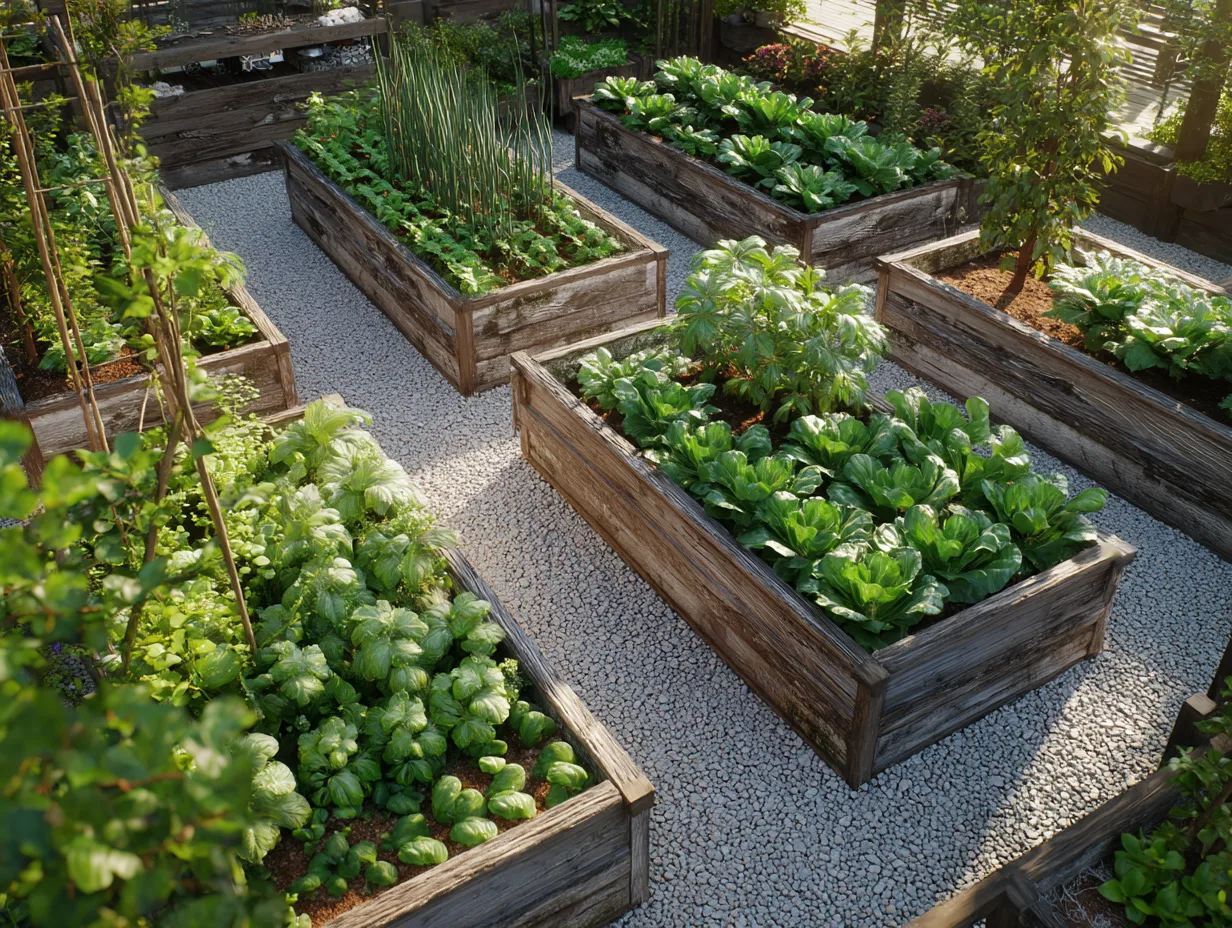Maximize Yield and Space
Raised beds turn ordinary soil into a high‑performance platform. Loose, fertile earth warms early, drains fast, and concentrates nutrients—perfect conditions for many crops that struggle in compacted ground. But some vegetables shine brighter than others when root room is shallow and square footage is limited. This guide on Best Vegetables to Grow in Raised Beds ranks top performers, explains why they excel, and shares pro tips for staggering plantings to harvest more from every inch. Along the way you’ll find internal links to deeper resources and external references from university extension programs for science‑backed advice.
Why Raised Beds Turbo‑charge Production
Raised beds aren’t just wooden boxes filled with dirt; they’re engineered micro‑ecosystems. Benefits include:
- Faster Warm‑Up: Elevated soil absorbs spring sun, letting you plant weeks earlier.
- Superior Drainage: Excess water drains laterally, keeping roots oxygenated.
- Loose Texture: No foot traffic compaction means roots explore freely, boosting nutrient uptake.
- Soil Customization: Blend compost, worm castings, and minerals to hit the perfect pH and fertility—see our primer on Best Organic Soil Additives.
- Space Efficiency: Intensive spacing, vertical supports, and succession planting squeeze farm‑size harvests into urban lots.
For a foundational overview of building boxes, read The Benefits of Raised Bed Gardening: Maximizing Space and Yield on our site; for this article we’ll focus specifically on crop choice and planting strategies.
Criteria for Selecting Raised‑Bed Superstars
Not every vegetable appreciates confined quarters. We ranked crops using four metrics:
- Root Depth Compatibility: Shallow to medium roots (<18 inches) thrive without subsoil access.
- High Yield per Square Foot: Plants that produce multiple harvests or vertical growth top the chart.
- Quick Maturity or Succession Potential: Fast turnover keeps beds productive.
- Ease of Maintenance: Minimal disease issues and straightforward trellising.
Leafy Greens: Salad Staples on Speed Dial
Lettuce (Leaf, Romaine, Butterhead)
- Spacing: 4–6 inches for baby cut‑and‑come‑again; 10 inches for heads.
- Raised‑Bed Advantage: Loose soil prevents tip burn and promotes even moisture.
- Yield Tip: Sow every 14 days for staggered harvests. Pair with shade cloth in midsummer—techniques covered in Growing Salad Greens.
Spinach & Asian Greens
Cool‑season champs that germinate in 40 °F soil—weeks before garden plots thaw.
- Bolt Resistance: Plant ‘Bloomsdale’ spinach or ‘Tatsoi’ in spring and fall.
- Soil‑Block Starts: Transplant in 1½‑inch blocks to avoid root disturbance—a method detailed in The Year-Round Vegetable Garden for Beginners.
Root Crops That Thrive in Fluffy Soil
Carrots
Raised beds let you skip double‑digging. Deep varieties like ‘Danvers’ grow straight when soil is stone‑free.
- Sowing Secret: Mix seed with sand for even distribution.
- Moisture Blanket: Cover rows with burlap until germination—reduces crusting (Cornell Cooperative Extension guide).
Beets
- Dual Purpose: Harvest greens at 30 days, roots at 60.
- pH Sweet Spot: 6.5–7.5 for robust bulbs—see Soil pH Testing.
Radishes
At 25 days to maturity, they’re the perfect gap filler alongside slow crops like peppers.
Fruiting Favorites for Vertical Gains
Indeterminate Tomatoes
Yes, heavy feeders with deep roots can succeed in 12‑ to 18‑inch beds when soil is rich and cages are sturdy.
- Variety Pick: ‘Sungold’ cherry or ‘Cherokee Purple’ slicing.
- Pruning: Remove lower foliage to improve airflow; details in Tomato Pruning Tips.
Cucumbers
- Trellis Height: 5–6 feet saves ground space.
- Pollination: Plant in blocks or add mason‑bee house—see Attracting Pollinators to Your Vegetable Garden.
- Bush Types: ‘Picklebush’ for container‑friendly vines.
Pole Beans
- Yield Factor: Vertical pods free soil for understory crops like basil.
- Inoculation: Dust seed with Rhizobium bacteria for nitrogen fixation.
Peppers
Thrive in the warmth of raised beds; mulch black landscape fabric to bump soil temperature.
- Hot vs. Sweet: Both perform, but sweets appreciate calcium—prevent blossom‑end rot with gypsum (see Identifying and Preventing Blossom‑End Rot).
- Density: Stagger 14 inches apart for maximum airflow.
Compact Squash and Melons
Bush zucchini like ‘Patio Star’ produce pounds of fruit in 3 square feet. Train miniature melons such as ‘Minnesota Midget’ on trellises; support fruit with nylon slings.
Herbs: High Value, Minimal Space
Parsley, cilantro, and chives tuck into corners. Basil loves warm, fluffy soil—pinch tips weekly for bushier plants. For perennial returns, establish thyme and oregano in dedicated edge pockets.
Planting Layouts for Maximum Yield
Square‑Foot Intensive Grid
- Divide a 4 × 8‑foot bed into 1‑foot squares.
- Follow recommended plants‑per‑square (e.g., 16 carrot seeds, 1 tomato).
- Rotate families each season—see The Essential Guide to Crop Rotation.
Layered Vertical Plan
- North Edge: Trellis cukes and pole beans.
- Center Row: Stake tomatoes and peppers.
- Front Edge: Sow lettuce, onions, and herbs for quick harvests.
Diagram and templates downloadable via our Small Plot, Big Harvest toolkit.
Soil Preparation and Amendments
Fill beds with a 50/50 mix of screened topsoil and mature compost. Boost with:
- Worm Castings: 5 % by volume for biological activity.
- Rock Phosphate or Bone Meal: Long‑term phosphorus.
- Greensand or K‑Mag: Potassium and trace minerals.
- Biochar: Improves water retention (research by Washington State University) .
Re‑test pH annually; adjust with lime or sulfur.
Watering and Mulching Strategy
- Install drip lines under 2 inches of organic mulch (shredded leaves, straw).
- Aim for 1–1.5 inches of water weekly; use a rain gauge.
- Check moisture at 3 inch depth—finger test beats guesswork.
Advanced irrigation setups explained in DIY Drip Irrigation Systems.
Pest and Disease Defense in Raised Beds
Raised beds reduce soil‑borne diseases by providing fresh mix, but vigilance remains key.
| Problem | Cause | Fix |
|---|---|---|
| Slugs on lettuce | Moist mulch | Beer traps, copper tape |
| Aphids on kale | Nitrogen spikes | Blast with water, release ladybugs |
| Powdery mildew on cucumbers | Humid foliage | Train vines vertically; spray potassium bicarbonate |
Explore holistic solutions in Eco‑Friendly Pest Control.
Succession Planting Calendar
| Month | Plant | Follow With | Notes |
| March | Spinach | Bush Beans | Remove spinach by June, pop in beans for soil nitrogen |
| April | Radish | Basil | Radish out by May; basil fills gap under tomatoes |
| May | Lettuce | Fall Carrots | Sow carrot seed in shade of maturing tomato canopy |
| July | Bush Beans | Fall Peas | Beans enrich soil; peas enjoy cooler August nights |
| August | Mini Cabbage | Garlic | Harvest by November; plant garlic for overwintering |
Detailed month‑by‑month alerts in our printable planner: How to Create a Garden Calendar.
Harvest and Post‑Season Care
- Cut‑and‑Come‑Again: Snip outer leaves, leave crown intact; regrowth within 10–14 days.
- Root Crops: Loosen soil with a fork, lift gently to avoid breakage.
- Spent Plants: Chop and drop as mulch or add to compost pile—guide in Composting 101.
In fall, sow cover crops like crimson clover to fix nitrogen and protect soil—more on What Is Green Manure?.
External Expert Resources
- University of Maryland Extension Raised Bed Guide – Soil mix ratios and pest tips.
- Royal Horticultural Society – Crop profiles and spacing charts.
- USDA Soil Health Portal – Research on compost and cover crops.
Bringing Raised‑Bed Potential to Life
Selecting the Best Vegetables to Grow in Raised Beds is part art, part science. Match shallow‑rooted, high‑yield crops to your bio‑intensive layout; layer quick maturing greens with towering tomatoes; replenish fertility with steady compost and smart cover crops. Raised beds repay the effort with cleaner produce, easier maintenance, and harvests that defy their footprint.
Ready to elevate your beds further? Dive into advanced techniques—like hoop‑house season extension, inter‑cropping flowers for beneficial insects, and winter cover‑crop cocktails—in The Year-Round Vegetable Garden for Beginners. With strategic plant choices and attentive care, every square foot of raised bed can become a powerhouse of flavor and abundance.


Leave a Reply